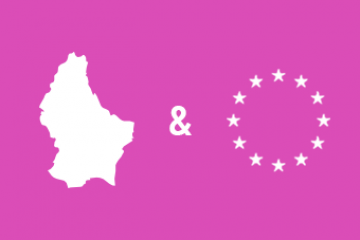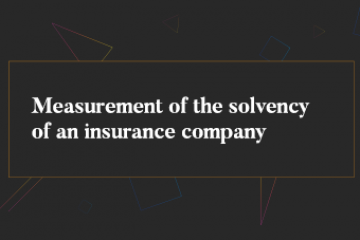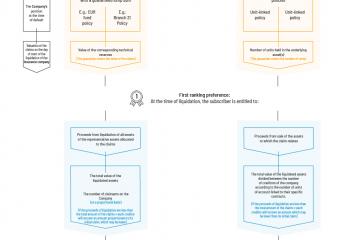Measurement of the solvency of an insurance company
Text version of the interview:
Solvency for an insurance company
The concept of solvency is about the ability for an insurance company to meet its long term obligations.
• The minimum amount of eligible own funds that a company must have in order to be able to continue its insurance activities without restriction is generally referred to as the solvency margin or Solvency Capital Requirement. This amount is set in accordance with regulations and is therefore intended to prevent insolvency situations and protect policyholders.
• The solvency ratio is calculated by dividing the eligible own funds by the Solvency Capital Requirement. A ratio above 100% means full compliance with regulatory requirements. The higher the ratio is, the stronger the balance sheet of the company appears.
What are the principles under which the Solvency Capital Requirement is assessed?
What is the relevance of the solvency ratio?
What does it actually ensure?
What happens in the event of non-compliance?
Are there any other aspects to consider?
To answer to these questions we must turn to the regulatory framework of the insurance sector.
European Directive 2009/138/EC
The regulation on solvency is based on the European Directive 2009/138/EC. It’s transposed in the law of each European country.
The regulation establishes a 3 pillars approach designed to assess and manage the risk borne by the insurer. This approach is common to all the insurance companies across Europe.
First pillar: Principles
The first pillar provides principles setting the basis for the calculation of the solvency capital requirement.
A company can lose its own funds and become insolvable. It occurs when a loss in own funds exceeds the initial value of the own funds.
A company is exposed to multiple risk such as market risk, underwriting risk, operational risk.
But own funds cannot cover all the situations. A balance has to be found between a reasonable level of confidence and the shareholder’s equity needed to operate the company.
What is that limit? i.e. what is the Solvency Capital Requirement which defines the minimum level of Own Funds from which the company can freely operate.
The Solvency Capital Requirement is defined as the Value at Risk of Basic Own Funds with a 99.5% confidence level over 1 year reflecting for all quantifiable risks.
In other words, of all the probable situations that can materialize over 1 year for a company in relation to its risk exposure, only 0.5% would exceed this amount. It reflects the company risk profile.
Another important element to take into account is the notion of Minimum Capital Requirement. It is calibrated on the Value at Risk of Basic Own Funds with a 85% confidence level, it lies between 25%-45% of Solvency Capital Requirement and has a minimum absolute value of € 3,7millions.
It defines the threshold under which immediate communication to the supervisor must be done.
If the Eligible own funds exceed the Solvency Capital Requirement, the company can freely operate.
If the Minimum Capital Requirement is less than or equal to the Eligible own funds which are themselves less than the Solvency Capital Requirement : the company has 2 months to submit a remediation plan to the CAA, 6 months (sometimes 9) to be compliant.
If the Eligible own funds are less than the Minimum Capital Requirement, the company has 1 month to propose a short-term refinancing measures. The CAA can restrict or access to deposited insurance assets. Should the company fail to submit such a plan or to execute it, the winding-up can be decided.
Second pillar: Governance standards
The second pillar sets governance standards allowing to identify, assess, manage and mitigate the risks.
The company must put in place reputation and experience requirements for board members. It must have key functions for risk management, actuary, compliance and internal audit.
There must be an effective risk management system. It must implement a own risk and solvency assessment process, a business plan of at least 3 years and stress scenarios. It must set limits and conditions for the outsourcing of critical functions or activities. And finally, to have effective procedures and controls in place for internal audit.
Third pillar: Reporting
The third pillar defines reporting to the regulator, the public and Administrative and Management Supervisory Board for greater transparency.
There are above 100 reporting templates for yearly reporting. Results are centralized by EIOPA for all European Companies. The Regular Supervisory Report summarizes business and performance, system of governance, risk profile, valuation for solvency, capital management. It is published at least every 3 years. The Solvency Financial Condition Report is a Yearly public disclosure subset of RSR information. The ORSA is the own risk and solvency assessment report for the Board of Directors.
In summary:
As you have understood, the robustness of a company is appreciated beyond the simple solvency ratio.
It lies in its ability to preserve it and to anticipate changes linked to strategic decisions or critical situations that affect its risk profile. In this context, risk management plays a central role.
The report on the company's solvency and financial situation allows you to read the solvency ratio at the end of a financial year, but above all to better understand its activity, its organisation, its risk profile and its means of defence. This report is public and is generally available on the websites of insurance companies or can be obtained on simple request.
When we talk about the solvency of an insurance company, we refer to its ability to meet its long term obligations. This solvency is measured by calculating a ratio based on the company's equity capital, but also by its own governance standards and the reporting to be done to the regulator.




















